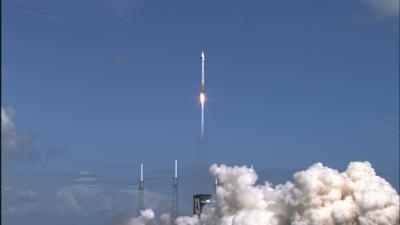Launch By ULA Went Off On Schedule At 1111 EDT Tuesday
A Cygnus cargo vessel was successfully launched by United Launch Alliance Tuesday morning at the opening of the launch window at 1111 EDT from Launch Complex 41 at Cape Canaveral.

The Orbital ATK cargo ship was boosted into orbit atop an Atlas V rocket into a clear, blue sky carrying more than 7,600 pounds of science experiments and crew supplies bound for the International Space Station. Cygnus separated from the Centaur second stage at 1133 EDT.
The Cygnus module is expected to arrive at the International Space Station early Saturday morning, about 6:05 a.m. as the laboratory flies over southern France. The crew will use the complex’s robotic arm to grab Cygnus and attach it to the station.
The Atlas V rocket performed very well during liftoff and climb to orbit, said Vern Thorp, United Launch Alliance’s program manager for commercial missions. “It was a beautiful launch,” Thorp said, pointing out that the Atlas booster performed at or slightly above expectations and that actual event times were very close to preflight predictions.
“It looks like we nailed the orbit once again,” he added. “At this time, it looks like a very good orbit insertion.”
The OA-7 Cygnus spacecraft was named in honor of John Glenn, the first American to orbit earth,” said Frank Culbertson, President of Orbital ATK’s Space Systems Group. “The S.S. John Glenn is dedicated to his legacy as a lifelong pioneer of human spaceflight who paved the way for America’s space program. The vital supplies we deliver to the astronauts on this mission and the scientific experiments we conduct for future exploration are a testament to his incredible achievements that will never be forgotten.”
After the cargo is removed and disposal items are loaded, Cygnus will depart from the station in mid-June and conduct three secondary payload missions. Cygnus is carrying the Spacecraft Fire Experiment-III (Saffire-III) marking the third time that the spacecraft has been used for these investigations as a unique environment to study fires in microgravity. Designed by the NASA Glenn Research Center, the results from the Saffire-III experiment will enable NASA to develop technologies to reduce crew risk and make deep space exploration safer for astronauts. NASA’s Advanced Explorations Systems Division sponsors the Saffire series of experiments as part of its deep space habitation development efforts that include technologies to make deep space exploration safer. In addition, a NanoRacks deployer will release four cubesats used for weather monitoring and global ship tracking. The final experiment will use three Reentry Data Collection Flight Recorders to provide crucial data about the extreme
conditions a spacecraft encounters when reentering the Earth’s atmosphere. This specific experiment will also test the performance of different heat shield materials that may be used on future U.S. space missions.
Pending NASA’s specific cargo needs, Orbital ATK is prepared to launch two additional CRS missions this year that will launch aboard the company’s Antares rockets from NASA Wallops Flight Facility in Virginia. Beginning in 2019, Orbital ATK will conduct a minimum of six initial cargo missions under NASA’s CRS-2 contract.
(Source: News releases and NASA blog. Image from NASA blog)
 ANN's Daily Aero-Term (04.25.24): Airport Rotating Beacon
ANN's Daily Aero-Term (04.25.24): Airport Rotating Beacon ANN's Daily Aero-Linx (04.25.24)
ANN's Daily Aero-Linx (04.25.24) Klyde Morris (04.22.24)
Klyde Morris (04.22.24) Airborne 04.24.24: INTEGRAL E, Elixir USA, M700 RVSM
Airborne 04.24.24: INTEGRAL E, Elixir USA, M700 RVSM Airborne 04.22.24: Rotor X Worsens, Airport Fees 4 FNB?, USMC Drone Pilot
Airborne 04.22.24: Rotor X Worsens, Airport Fees 4 FNB?, USMC Drone Pilot



